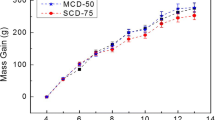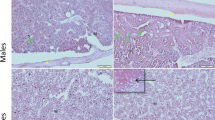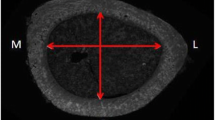Abstract
The effects of dietary boron (B) (from boric acid [BA]) on bone strength were evaluated using male F344 rats. B was administered by dietary admixture of BA to NIH-07 feed at concentrations of 200, 1000, 3000, and 9000 ppm. The latter two levels were found in previous studies to be reproductively toxic to both males and the developing fetus. The first two levels are below and just at, respectively, the levels for producing fetal malformations, and are below the dose required to produce male reproductive toxicity.
Resistance to destructive testing was measured on femora, tibiae, and lumbar vertebrae. Although femur and tibia resistance to bending force were not affected by any amount of dietary B, vertebral resistance to a crushing force was increased by ≈10%, at all dose levels (200-9000 ppm). These data show that even levels of BA that are not reproductively toxic can affect the strength of the axial skeleton in rats.
Similar content being viewed by others
References
B. S. Seal and H. J. Weeth, Effect of boron in drinking water on the male laboratory rat.Bull. Environ. Contam. Toxicol.25, 782–789 (1980).
F. H. Nielsen, C. D. Hunt, L. M. Mullen, and J. R. Hunt, Effect of dietary boron on mineral, estrogen, and testosterone metabolism in post-menopausal women,FASEB J. 1, 394–397 (1987).
F. H. Nielsen, L. M. Mullen, and S. K. Gallagher, Effect of boron depletion and repletion on blood indicators of calcium status in humans fed a magnesium-low diet,J. Trace Element Exp. Med. 3, 45–54 (1990).
W. W. Ku, R. E. Chapin, R. F. Moseman, R. E. Brink, K. D. Pierce, and K. Y. Adams, Tissue distribution of boron in male Fischer rats,Toxicol. Appl. Pharmacol.111, 145–151 (1991).
R. E. Chapin, W. W. Ku, M. A. Kenney, H. McCoy, B. Gladen, R. N. Wine, et al., The effects of dietary boron on bone strength in rats,Fundam. Appl. Toxicol. 35, 205–215 (1997).
H. McCoy, R. Orrell, M. A. Kenney, and L. Williams, The effect of storage time on bones from rats fed low-magnesium or low-calcium diets,FASEB J. 3, A1309 (1989).
R. F. Moseman, R. E. Brink, C. W. Jameson, K. A. Treinen, and R. E. Chapin, Method development and validation for the determination of ppm levels of boron in rat tissue,Toxicologist 11, 278 (1991).
M. A. Kenney, H. McCoy, and L. Williams, Effects of dietary magnesium and nickel on growth and bone characteristics in rats,J. Am. Coll. Nutr.11, 687–693 (1992).
Author information
Authors and Affiliations
Rights and permissions
About this article
Cite this article
Chapin, R.E., Ku, W.W., Kenney, M.A. et al. The effects of dietary boric acid on bone strength in rats. Biol Trace Elem Res 66, 395–399 (1998). https://doi.org/10.1007/BF02783150
Published:
Issue Date:
DOI: https://doi.org/10.1007/BF02783150




